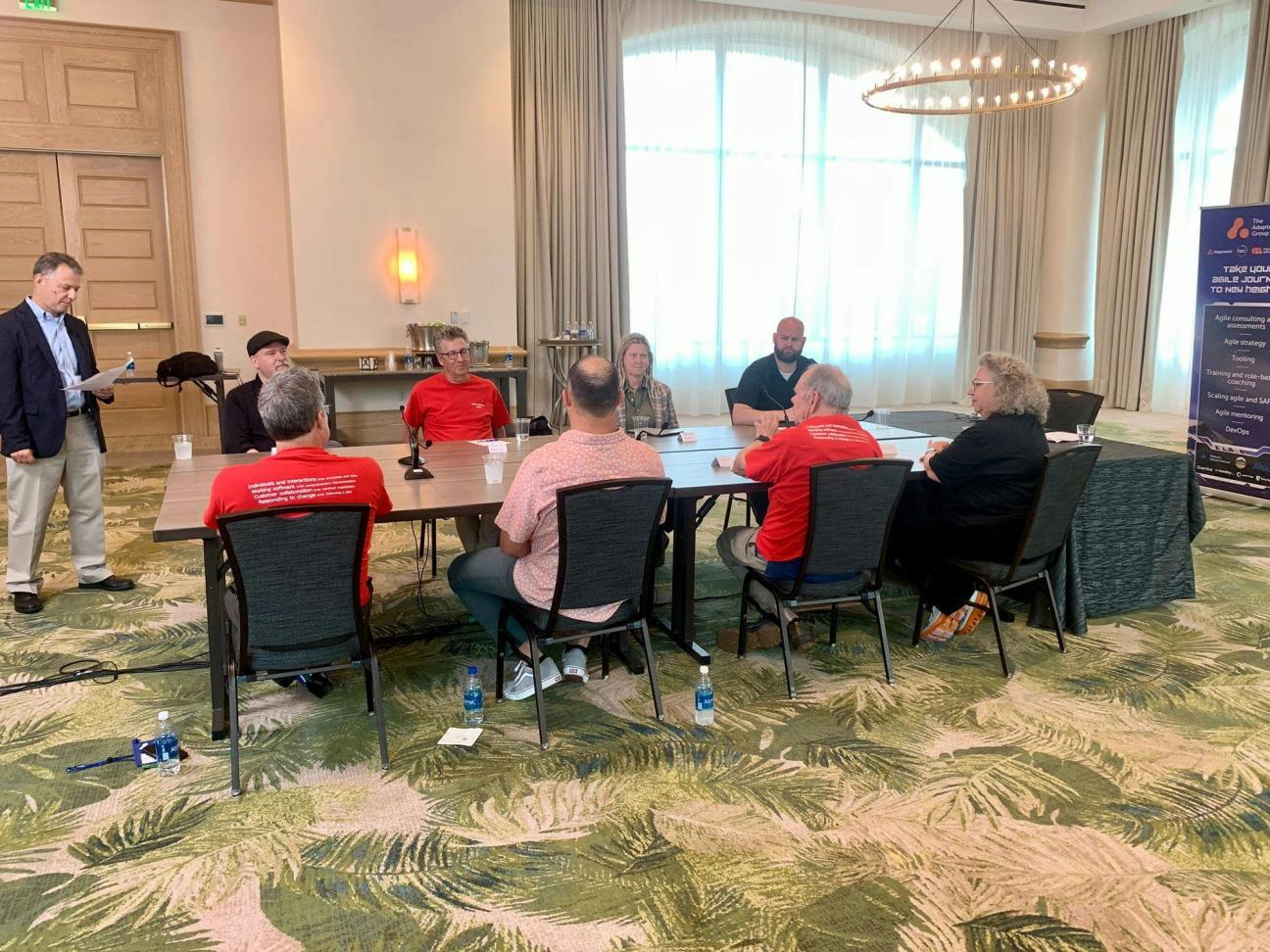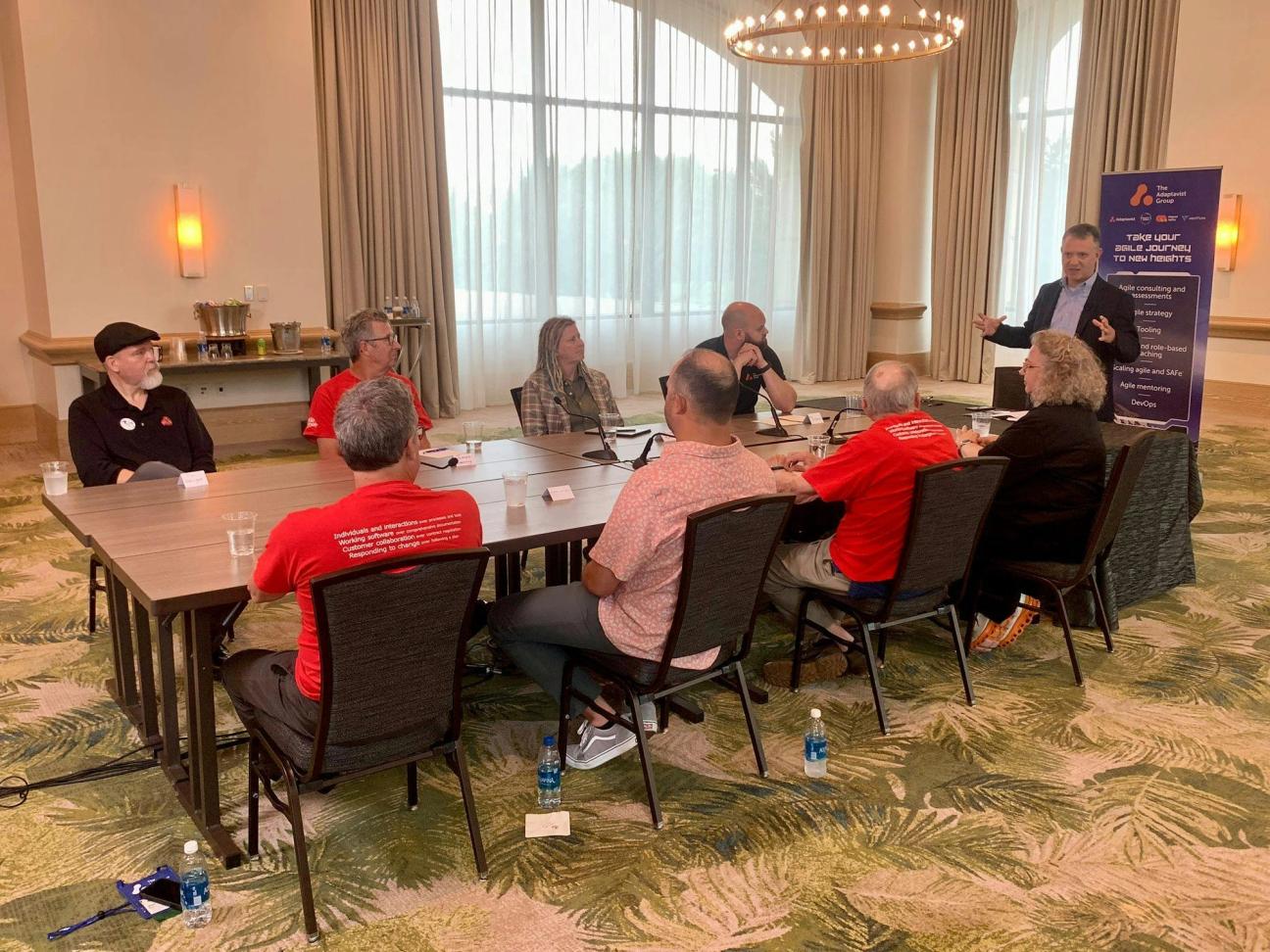The State of Agile: Going Back to Basics
Share on socials
The State of Agile: Going Back to Basics

Jon Kern
Published on 4 October 2023
13 min read


Jon Kern
Published on 4 October 2023
13 min read
Agile methodologies have become ingrained in software development and beyond over the past two decades. However, as the concept spreads, has its original intent been lost?
To discuss the current state of agile and re-examine its core principles, The Adaptavist Group hosted an insightful 'Back to Basics' roundtable in Orlando.
The session brought together a high-calibre panel of leading lights in the world of agile (including three of the original co-authors):
From The Adaptavist Group:
- Jon Kern, Agile Consultant, Adaptavist, and original Agile Manifesto co-author
- Tina Behers, VP Enterprise Agility, Aligned Agility
- Philip Heijkoop, General Manager, Aligned Agility
Joining them:
- Jim Highsmith, Agile Manifesto co-author and author of Agile Project Management
- James Grenning, renowned Embedded TDD coach and Agile Manifesto co-author
- Tim Ottinger, agile thought leader and consultant at Industrial Logic
- Ronica Roth, expert coach and co-founder of The Welcome Elephant
- Andrew Satriano, Agile Sales Director, Apptio
Key themes centred on agile often being misapplied and misunderstood, debunking common myths, defining what an agile mindset and culture really are, and practical advice for improving agile efforts. The discussion offered a golden opportunity to re-examine the origins of agile and put its core principles in today's context.
The roundtable was expertly moderated by Isaac Sacolick, President of StarCIO and contributing editor of InfoWorld and CIO Magazine.
Why isn’t agile living up to its full potential?
Agile methodologies promise more effective delivery of higher-quality products, the ability to thrive in an uncertain environment, and an all-around better culture and sustainable way of working. However, the roundtable experts agreed that agile adoption is falling short of realising its full potential.
A victim of its own success?
A key issue cited was that agile has become a victim of its own success. With widespread adoption across multiple industries, agile has been interpreted and implemented in a whole host of different ways. This has led to confusion between 'doing agile' (implementing processes) versus 'being agile' (ingraining an agile mindset focused on outcomes). As Philip Heijkoop explained, "A lot of people will focus on asking 'How agile are we?' as if agile is the point. But we're not here to measure how well we're adhering to whatever principle of agile we're doing. Agile is a means to an end—delivering value better, faster, with higher quality."
Interpreting the Manifesto
This theme of agile being a victim of its own success naturally led to a discussion around the Agile Manifesto. Participants, including three original co-authors, engaged in an in-depth discussion on the famed 12 principles and whether they are still fit for purpose. The authors all agreed that the manifesto had grown beyond their wildest dreams since its 2001 authorship. According to Jon Kern:
"The manifesto had no expectation—publishing it was almost an afterthought. No one thought it would set the world on fire. We unleashed something personal and hit a sweet spot."
Jon Kern
Agile Consultant

Defining an agile mindset
A central discussion during the roundtable revolved around demystifying the term 'agile mindset'. While the right mindset is often cited as crucial for agile success, a true definition is hard to pin down. Our experts helped distil an agile mindset down to six core principles.
1. Adaptability sits at the forefront of an agile culture. Agility is all about continuous learning, adaptation, and giving people the freedom to fail. You have to sense what is out there, look around the corner, and anticipate what's coming. And then you have to be ready and willing to pivot in a new direction based on everything you've learned.
2. Flexibility is another cornerstone. Agile teams should never be overworked. An agile culture recognises that every team, and every individual, is different, and that they're all going to approach agile differently. This is crucial to ensure teams aren't overwhelmed by rigid protocols.
3. Trust forms the bedrock of agile interactions. Everyone is striving towards the same goals. Management has the right to ask about deadlines, costs, and rationales, but developers have a right to push back on unrealistic expectations and challenge assumptions. As Jon Kern noted, "The idea is to gain each other's trust because we're in this together, trying to do the right thing."
4. Collaboration is pivotal. Rather than a command and control mindset—
"Agility means business leaders share what value looks like and technical teams figure out how to realise as much of that value as possible, with the time and people available."
Jon Kern
Agile Consultant
5. Communication is the linchpin that holds everything together. If leaders haven't published and clearly communicated organisational vision and strategy, there is no way for product managers or product owners to set priorities. Tina Behers shared a cautionary tale: "I've been in situations where the head of product or the CEO has taken a leave of absence from the company. And because the vision was not communicated, the next layer down didn't know what to work on or what was important."
6. Lastly, fostering an adventurous spirit is non-negotiable. There's a perception out there that agile teams are risk-averse, but that isn't true. Agile organisations need adventurous, non-conformist people at all levels who are prepared to take risks and challenge the status quo.
Improving agile
With common problems and misconceptions identified, the experts provided practical advice for improving agile adoption.
Talk to your neighbours: An overarching theme was instilling an interaction-first approach. "The collective is much stronger than the individual," said Andrew Satriano. It's vital organisations encourage and make it possible for employees to talk to each other—not just the people sitting closest to them. Not to mention the need to talk to the customers!
Keep vision in sight: Without a strong vision, communicated early and often, agility cannot happen. Everyone needs to know what they're working towards and why. Constantly repeating and reinforcing the vision enables everyone to know what outcomes are truly important.
Have shared context: Use the same language to describe the same things across the business. Rather than developers using their own terms, which can create division and confusion, using the same real-world (domain) language helps unite teams and supports consistency.
Reward success and failure: Transformation is no mean feat, so it's vital you celebrate all the wins working with agility can bring. That includes rewarding teams when they learn from failure, encouraging employees to be adventurous, reflecting on what's not working, and adapting accordingly.
Be bold and experiment: Experimentation is critical. When you're exploring the unknown, there's risk involved. That means managing the fear of failure is key. Ronica Roth stresses that this is an iterative process:
"If you want to create a culture where it’s safe to fail, where people can bring their ideas, that doesn’t happen magically. It happens because of little practices every single day."
Ronica Roth
Co-CEO, The Welcome Elephant
Be on the same team: Buy-in from business leaders is essential, but it's much easier to achieve if everyone feels like they're in the same boat. "Make sure that it's not an us-against-them scenario with leadership and the rest of your team," says Philip Heijkoop.

The future is bright
The Back to Basics roundtable provided invaluable insights into the current state of agile, directly from some of the world's leading experts. While agile has spread rapidly, it's clear there are still many obstacles hindering its success.
Agile transformation is no easy process, but a willingness to learn and adapt will help organisations realise its full benefits. As long as there is a transparent collaboration between trusting teams and leaders, agile ways of working can thrive.
With the right environment and mindset focused on outcomes over protocols, businesses can continue delivering value quickly and with high quality. By going back to agile basics, and instilling its core principles across every level, the future looks bright. The journey requires patience, communication and trust, but the destination is well worth it.
If you're ready to put agility on the agenda, the experts at The Adaptavist Group are here to help. From our wealth of resources to our highly experienced consultants, we cover the breadth of agile, including leadership and mindset coaching, strategy workshops, business agility assessments, tooling selection, and implementation. Our team has the expertise and experience to take your transformation further, so your organisation can reach new heights of business agility.
Attendees conceded that as the Agile Manifesto was originally written in 2001 for software teams in waterfall environments, today's challenges require learning how to apply it in modern business contexts. However, they all believed the values (especially) and the principles are as sound as they were 20 years ago. Co-author Jim Highsmith stressed interpreting the meaning rather than the literal words: "It's like raspberry jam: the wider you spread it, the thinner it gets. We need to help people thicken it up where it's thin. It needs to be interpreted in terms of intent—not words."
Fear of failure
Finally, risk-averse leadership often limits agile success. While agile can be used to manage uncertainty, this isn't always clear to C-suites that are firmly focused on deliverables. As Ronica Roth noted, "Business leaders are often afraid of failure and the uncertainties of knowledge work. Agile is a great risk management tool, but its advantages aren't always clear. There are messy parts in the middle, even with efforts to create transparency. This can make leaders anxious, leading them to say, 'Just give me a plan so I can sleep at night!'"
Debunking agile myths
Participants then attempted to unpick and clarify the myths and misconceptions that plague agile implementations across the enterprise space. Some of the key misconceptions discussed include:
1. Agile means no documentation: While some believe agile forgoes documentation, the reality is more nuanced. The Agile Manifesto emphasises "working software over comprehensive documentation", but 'over' doesn't mean 'instead of'. Agile doesn't eliminate documentation, but emphasises creating actual usable software instead of excessive documentation that is only a proxy of the final end product, and not the product itself.
2. Agile doesn't scale: Contrary to the belief that agile can't scale, participants suggest that businesses can start small, with one team or department, and then spread from there. Uniform principles, not identical practices, are keys to scaling. It's about adapting to fit larger organisational structures without losing the core agile values.
3. Agile is just for teams: Whatever your teams are doing still has to work within the wider context. Being agile doesn't mean sidelining other essential functions. It's about ensuring the agile team's practices and processes fit seamlessly within the broader organisational context.
4. There's only one way to be agile: There's no one-size-fits-all in agile—even its authors are still learning how to implement it! Agile is not a strict set of rules, but rather it is a guiding philosophy that can be interpreted based on specific contexts. Emphasis should be placed on interaction-first collaboration as hinted at in the first value: "Individuals and interactions over processes and tools."
5. Agile is rushed: Agile does not demand rushed, pressured work. Proper amounts of upfront work still apply. Testing, architecture, and design are still integral. Agile promotes continuous learning and adaptation. It's not about cutting corners, but about optimising processes and efforts to maximise effectiveness.
Written by

Agile Consultant
Jon is a co-author of the Agile Manifesto and is passionate about helping clients succeed in delivering business value through software. At Adaptavist, he works with distributed teams to articulate, design, architect, and deliver software that solves challenging business problems.